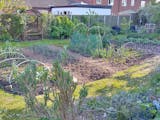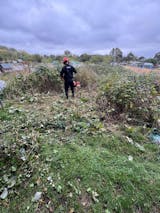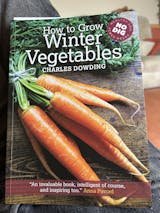I'm writing on 16th November, after decent weather with nothing too cold. The average temperature by day has been 12°C, and by night, 6.5°C, that's roughly 54°F to 44°F. We've had a few light frosts and you can see from the main photo how lush the garden still is, with plenty of green.
There has been almost no rain, just 1.8mm!
That's about to change and there's plenty to do at this time, as preparation for winter and spring. See my new video tour for late-autumn ideas from Homeacres.

Time to mulch
A mulch is any material on the soil surface. For no dig I find it works brilliantly to spread just once a year around 2.5 cm/1 inch of new compost on the surface of all beds. Compost can be anything that is mostly decomposed. That includes old animal manure, preferably with straw bedding, rather than woody material.
It might also be compost you buy such as mushroom compost, and green waste compost. Or leaf mould you made last year, see my Compost book for inspiration and methods..

Your own compost may certainly be less perfect-looking than contents of the dalek, in the photo above. As long as compost is mostly dark brown and reasonably soft, it's good to spread. And you don't need to sieve it, we never do that unless it's for potting mix. My podcast with BBC Gardeners World covered many of these topics.
Perhaps some large pieces of wood are still there - you simply pick them out to put into the current heap.
If the compost is smelly, it's definitely best to spread it. Because air then enters and it becomes sweet. By spring it will be unrecognisably soft and improved, while during winter it has been nourishing soil life, rather than sitting in a heap.


On pathways, my mulch is half composted woodchip with not too large pieces. We spread it around one to 2 cm or a half inch in depth.
I find if the woodchip is deeper than that, the paths can become as high as the beds, and then wood scatters over the bed surface. It gets in the way of seeds and seedlings, plus it can encourage too many woodlice / pillbugs.
If the only woodchip you have is fresh, that's fine to use. Just I would remove the larger pieces of wood, unless your paths are deep, perhaps also they are between wooden sided beds. I do not use sides, because of cost and the space needed. They make it harder to reach the middle!. Plus they tend to harbour slugs on the inside where the wood is decaying.

Harvests before and during the cold
I love parsnips because they are one vegetable that can stay in the ground, even in very low temperatures. Like many roots and leaves, they grow sweeter as it turns colder, but even now in mild conditions, they are tasting delicious.

The forked parsnips whose fangs were cooked by Nicola, came from a bed of forked soil. It's one bed of 18 in a Three Strip Trial where 10 years of annually loosening the soil of Strip 1's six beds, with a fork and without inversion, has decreased output by 8%.

The forked beds receive the same amount of surface compost as the no dig beds next to them. Plantings in each strip are the same, see the drone photo below.

We are in the process of mulching these beds and paths, after clearing final harvests.
The right hand bed in the photo above has a mulch of old cow manure which turns out to contain a lot of grass and weed seeds. They are still tiny, almost invisible, which is a brilliant moment to disturb them with a hoe and that's the tool you can see on the surface. Winter weeding is important.

Vegetable hardiness
As with parsnips, savoy cabbage are remarkably hardy to frost. That's because the leaves are less tight in the heads, compared to white and red cabbage. Their heads can split and then rot if it's a deep frost.
Heads of radicchio likewise, so we shall be harvesting them this coming week before it gets too cold. They store in great condition, just in a garden shed, even if it freezes slightly. The humid air at this time of year helps them to keep in good condition.

Frost sensitive plants include bulb fennel and celery. A little harder than them are winter radish, while beetroot that are standing above ground can take temperatures down to about -4°C 25°F. So I'm planning to harvest them before the end of November. We leave some soil on the roots and put them in boxes.


As the poet wrote,
If winter comes, can spring be far behind?
Now is a great time to study and prepare for those busy months. You can learn about each vegetable's best growing practice in my Seed to Harvest online course. Plus, we have separated it into 30 guides which you can buy separately, for each vegetable. Many of them have videos you will not find on YouTube.












































0 comments